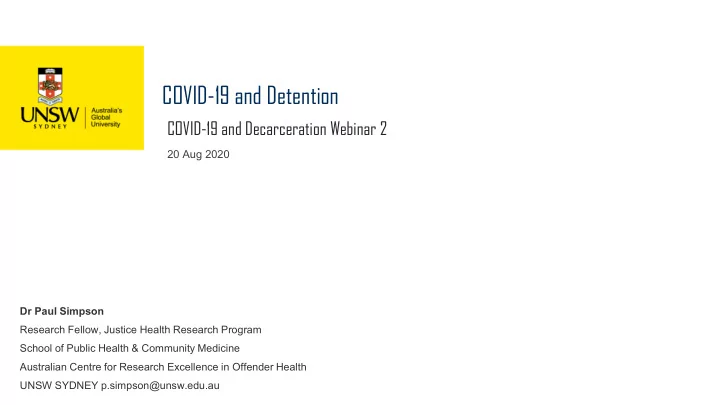

COVID-19 and Detention COVID-19 and Decarceration Webinar 2 20 Aug 2020 Dr Paul Simpson Research Fellow, Justice Health Research Program School of Public Health & Community Medicine Australian Centre for Research Excellence in Offender Health UNSW SYDNEY p.simpson@unsw.edu.au
1. How important has decarceration been as a response to COVID-19? Three things that tell us decarceration is important in the COVID-19 era 1. Historical examples of prisons as incubators of infectious diseases: 16th century typhus (“gaol fever”) in English prisons; 20 th century tuberculosis in Russian prisons¹‾⁴ 2. Recent systematic review of evidence (pre-COVID-19) : Prison cell spatial density is likely associated with infectious and communicable diseases transmission in prison⁵ 3. COVID-19 measures for prisons overlook the asymptomatic issue: The assumption that COVID-19 is containable through the identification of prisoners with clinical signs or symptoms⁶ 1
2. What have been the key issues, opportunities and challenges around this? 1. Reactive not preventive approach to decarceration • Decarceration required before an index case enters the prison, as preventing an outbreak is likely to carry fewer challenges and reduced health and economic costs than controlling a substantial outbreak, which will include extensive contact tracing, isolating or quarantining those released into community settings 2
Prisoner population in New South Wales since COVID-19 public health measures were implemented ⁸ Chan, N. (2020). NSW Bureau of Crime Statistics and Research 3
2. What have been the key issues, opportunities and challenges around this? 1. Reactive not preventive approach to decarceration • Decarceration required before an index case enters the prison, as preventing an outbreak is likely to carry fewer challenges and reduced health and economic costs than controlling a substantial outbreak, which will include extensive contact tracing, isolating or quarantining those released into community settings 2. Mitigating the collateral effects of existing prison COVID-19 measures • Collateral effects: prisoner mental health issues, prisoner resistance, family strain • Raise human rights concerns • Decarceration can help, but who is left behind? 4
3. What has been missing from the response, in relation to decarceration and COVID-19? What are the impacts of this? Missing: Lack of investment and discourse on community reintegration preparedness • Well managed decarceration program requires integrated health, social, and economic supports in place • Effective collaboration between government departments, prisoner support organisations and NGOs • Situation more acute when returning to community during COVID-19 related restrictions Impacts • Increase risk of poor health outcomes, including COVID-19 infection in communities with high prevalence rates, homelessness, recidivism. • Contributes to lack of governance and leadership on decarceration strategies • Incarceration is the easier default option?? 5
4. What are the three biggest priorities in order to respond sustainably and effectively For the next year? • Targeting prisons with high spatial density • Listen to prisoner support and peer-based organisations • Telehealth and telesocial services For the next three years? • Integrative health care and housing in the community • Changing public attitudes to prisoners • Recognising decarceration as an opportunity 6
References 1. Howard J. Prisons and Lazarettos. The state of the prisons in England and Wales. (First published 1777). Patterson Smith, 1973. 2. Stern V. Sentenced to die? The problem of TB in prisons in Eastern Europe and Central Asia. International Centre for Prison Studies, 1999. 3. Coker R. Detention and mandatory treatment for tuberculosis patients in Russia. Lancet 2001;358:349-50. 10.1016/S0140-6736(01)05587-8 11502311 4. Mercer AJ, Jacobs B, Moon S, Kynch J. Prisons and the tuberculosis epidemic in Russia. J Int Dev 2003;15:559-7410.1002/jid.1003. 5. Simpson PL, Simpson M, Adily A, Grant L, Butler T. Prison cell spatial density and infectious and communicable diseases: a systematic review. BMJ Open 2019;9:e026806. 10.1136/bmjopen-2018-026806 31340959 6. Butler T, MacIntyre R, Simpson P, Levy M. Legal Aid NSW Report on COVID-19 and the impact on NSW prisoners, 2020; Kirby Institute, Sydney 7. Simpson PL; Butler TG, 2020, 'Covid-19, prison crowding, and release policies', The BMJ, vol. 369, http://dx.doi.org/10.1136/bmj.m1551 8. Chan, N. (2020). The impact of COVID-19 measures on the size of the NSW adult prison population (Bureau Brief No. 149). Sydney: NSW Bureau of Crime Statistics and Research. 9. Astor JH, Fagan TJ, Shapiro D. The Effects of Restrictive Housing on the Psychological Functioning of Inmates. Journal of Correctional Health Care 2018;24:8-20. https://journals.sagepub.com/doi/full/10.1177/1078345817744795
Recommend
More recommend